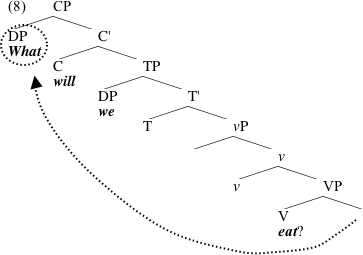
(1) What did the dragon devour?
(2) Which bearded syntactician did you see?
(3) On which table did you put the book?
(1) demonstrates a familiar kind of problem; the verb devour selects for a DP complement, and we have a theory of how such selection can be satisfied (involving both our theory of phrase structure and our approach to selection) which ought to force the DP to be the sister of devour. But this clearly isn't the case in (1); the complement of devour, intuitively, is what, but these two words are nowhere near each other.
Classically, we've coped with problems like this by positing movement operations. We might, for example, posit movement of what to some position at the beginning of the sentence. But this movement will have to differ from the types of movement we've seen so far, in a couple of respects. What is a DP, and our examples of A-movement have all involved movement of DPs; our hypothesis was that A-movement is driven by DP's need for Case. But not all instances of this type of movement involve movement of DPs; the phrase at the beginning of example (3), for example, is a PP.
So this is something new. Words like what, when, where etc., which undergo this type of movement, are typically called wh-words, and the movement is called wh-movement (and the questions formed by the movement are wh-questions). Wh-words get their name from the fact that in English, they mostly begin with the letters 'wh'; the technical term 'wh-word' is applied to words that have these meanings in any language, however, no matter what sounds they start with. A phrase which contains a wh-word (like on which table in (3), which contains the wh-word which) is called a wh-phrase.
One reason for viewing wh-movement as movement can be found in a dialect of English spoken in Ireland, called West Ulster English.
|
Optional Reading: The data discussed here are taken from: McCloskey, James. 2000. Quantifier float and wh-movement in an Irish English. Linguistic Inquiry 31.57-84. |
This dialect of English is like many dialects (including mine) in that it allows speakers to mark wh-words as plural by putting the word all after them:
(4) What all did she buy in Derry yesterday?
In example (4), if our theories of selection are right, the phrase what all should have moved from a position after buy to its current position as the front of the sentence. What is unusual about this dialect is that it allows for other placements of all; in particular, (5) is grammatical in this dialect (though not in mine):
(5) What did she buy all in Derry yesterday?
Moreover, the generalization is not simply that all may be placed in any random position in the sentence; (6) and (7), for example, are ill-formed:
(6) *What did she buy in Derry all yesterday?
(7) *What did she buy in Derry yesterday all?
The generalization, then, is that all may appear next to the wh-word, or in the position the wh-word has moved from.
This is a familiar kind of phenomenon. When we were first looking at A-movement, we discussed the distribution of Japanese floated numeral quantifiers, which had a similar type of distribution; they can appear either next to a DP or in the position that that DP has A-moved from. The West Ulster English data are of a similar kind; we can analyze (4-7) by saying that the phrase what all is undergoing wh-movement, and optionally leaving part of itself behind as it does so. As a result, all can only appear in positions which are currently or formerly occupied by this phrase.
Wh-movement, then, is a type of movement. In English, at least, it appears to be movement to the specifier of CP:

In a question like the one in (8), the wh-word what appears at the beginning of the clause. There is also another type of movement going on here, which we'll talk about later, which relocates will from T to C (it's called head-movement).
We have already seen that wh-movement differs from A-movement in at least one way; it is capable of moving phrases which are not DPs:
(9) [How loudly] should we yell?
(10) [Under which rock] did you find the treasure?
Another difference between wh-movement and A-movement has to do with binding theory. A-movement is capable of creating new binders for anaphors, as the contrast between (11) and (12) shows:
(11) * It seems to himselfi that Johni is a genius.
(12) Johni seems to himselfi to be a genius.
(11) violates Principle A of the binding theory; the anaphor himself is not bound. In (12), by contrast, himself is bound by John, and Principle A is satisfied. Now, we've been analyzing (12) as an instance of raising; John doesn't get a theta-role from seems (or from a v associated with it), but rather gets a theta-role somewhere in the infinitival complement clause, and raises up into the matrix specifier of TP to get Case. If this analysis of (12) is right, though, then from its original position, John wouldn't have been able to bind himself; just as in (11), John wouldn't have c-commanded himself. So the well-formedness of (12) shows that A-movement can create new binders for anaphors.
Wh-movement seems not to be able to do this, however. Demonstrating this is a little bit tricky. Straightforward examples like the one in (13) don't quite show what we want to show:
(13) *Whoi did you tell himselfi about?
Here who starts out as the complement of the P about, and moves into the specifier of CP. And the result is indeed bad, on the reading in which who and himself are coindexed (that is, this isn't a way to say "Who did you tell about himself?"). But our existing binding theory might be able to predict this, even without invoking any differences between A-movement and wh-movement. After all, if you calculate the binding domain of himself in (13), you'll see that it's the matrix TP; that's the smallest TP containing himself and a DP (in this case, you) which c-commands himself. Now, let's consider the tree for (13):
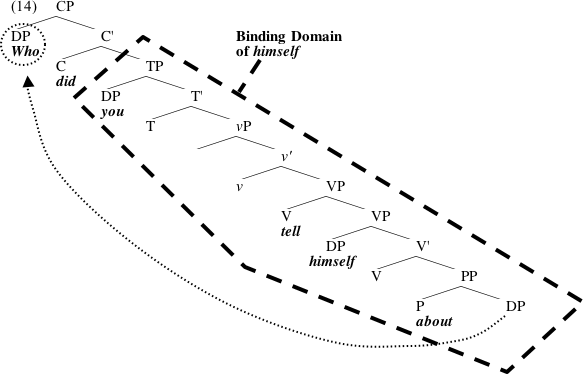
If this is the right tree for (13), and if our binding theory is right about this TP being the binding domain for himself, then we don't actually need to add any assumptions to prevent this instance of wh-movement from creating a new binding for himself; who just isn't inside the binding domain of himself.
It is possible to show that wh-movement is different from A-movement in this regard, however. Consider an example like (15):
(15) Johni thinks that the pictures of himselfi are too heavy for me.
In this example, the binding domain for himself is clearly larger than its clause; it includes John, the subject of the higher clause. Now we can change (15) slightly so that there's wh-movement to the middle of it:
(16) Johni wonders whoj pictures of himselfi/*j are too heavy for.
In (16), who has wh-moved to a position preceding himself. We know that the binding domain for himself includes this position; in fact, it even includes higher positions, like that of John. And yet, the example can't be understood with who as the binder for himself.
Note that the problem is not that who can never be a binder for an anaphor:
(17) Whoi criticized himselfi?
In (17), we can see that wh-words can be binders for anaphors. It's just that wh-movement, unlike A-movement, doesn't create new binders for anaphors. In (17), who would be able to bind himself even if it didn't wh-move; in (16), by contrast, we can see that a wh-word can't bind an anaphor from its wh-moved position.
Movements like wh-movement, which cannot create new binders for anaphors, are often called A-bar movement (also written A'-movement). "A-bar", in this context, just means "not A"--that is, this is the type of movement (of phrases) which is not A-movement.
Example (16) above illustrates something else about wh-movement; we can find instances of wh-movement in embedded clauses. We already know that there are verbs which select for questions as their complements:
(18) Mary wonders whether John bought a book.
(19) Mary wonders who bought a book.
(20) Mary wonders what John bought.
(21) Mary wonders why John bought a book.
(22)*Mary wonders that John bought a book.
Examples like the ones in (18-21) aren't questions; they're statements. But the complement of the verb is a question; (20), for example, means that Mary wants to know the answer to the question which is the complement of the verb (namely, "What did John buy?"). The statement in (20) would have a tree like the one below, where wh-movement has taken place to the specifier of the embedded CP:
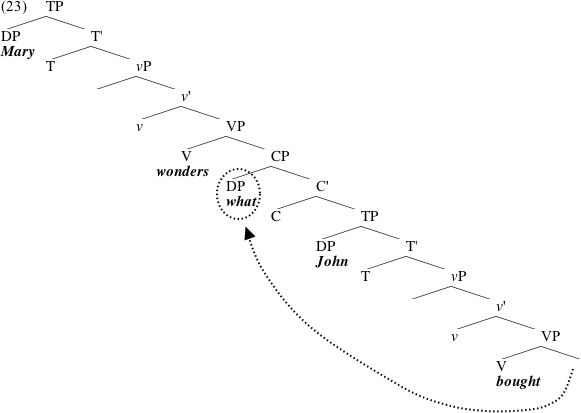
Note that English embedded questions differ from English matrix questions, in many dialects, in at least one way; matrix questions have movement of T to C, but embedded questions don't:
(24) I wonder what John will buy.
(25) *I wonder what will John buy.
(26) What will John buy?
(27) *What John will buy?
The judgment in (25) is a point of dialect variation; there are dialects of English that accept (25).
These examples all illustrate another point about English, which is that if a wh-phrase is in the specifier of a CP, there must be no overt complementizer in C:
(28) *I wonder what whether John will buy.
This generalization (that no overt complementizer can appear in C if there is a specifier of CP) is known as the Doubly Filled COMP Filter. This filter is a point of cross-linguistic variation; Dutch, for example, does not observe it:
(29) Ik weet niet wie of Jan gezien heeft. I know not who C Jan seen has. 'I don't know who Jan saw'As (29) shows, the Dutch overt complementizer of may have a wh-phrase in its specifier.
Another point of cross-linguistic variation has to do with the size of the phrases which can undergo wh-movement. Many of the wh-movement examples above involve wh-movement of a single wh-word. But the wh-moved phrase can be much larger than this:
(30) [What] did he buy?
(31) [Whose car] did he buy?
(32) [Whose parents' car] did he buy?
In fact, as the examples in (30-32) hint, there is no limit on the size of a wh-phrase. In other words, a wh-phrase can be much larger than a wh-word.
In the particular examples in (31-32), in fact, the wh-phrase must contain words other than the wh-word whose; movement of whose by itself is ill-formed in English in these contexts:
(33) * [Whose] did he buy car?
On the other hand, there are languages, like Russian, in which questions like (33) are well-formed:
(34) Čju on kupil mašinu? whose he bought car 'Whose car did he buy?' (literally, "Whose did he buy car?")So here is another point of cross-linguistic variation; in Russian, a possessor can simply be wh-moved, while in English, a possessor must bring the possessed noun along with it if it is to be wh-extracted. This type of phenomenon, in which a wh-word embedded in a phrase causes that phrase to undergo wh-movement, is called pied-piping; the reference is to the fairy tale of the Pied Piper of Hamelin (the idea being that the wh-word, like the Pied Piper, is forcing other things to follow it).
Another cross-linguistic difference with respect to pied-piping has to do with PPs. English is rather unusual, cross-linguistically, in allowing the complement of a preposition to wh-move, leaving the preposition behind (a phenomenon sometimes called preposition stranding):
(35) Who did you talk to?
In Russian, for example, this is impossible; if the object of a preposition is to undergo wh-movement, the entire PP must be pied-piped:
(36) a. S kem vy razgovorivali? to whom you talked 'Who did you talk to?' b.* Kem vy razgovarivali s? who you talked toSo the rules of pied-piping appear to vary from language to language. There are some universals, however; for instance, no language has been found in which the object of a verb pied-pipes the VP when it is extracted:
(37)*[Buy what] will you?
Now that we have discussed what is moving in wh-movement, let us return to the question of where movement can land. We have already decided that wh-movement is to the specifier of CP. What happens in sentences with multiple CPs?
(38) What did he say that he wanted?
We already know that what in this example begins as the object of wanted, and moves to the specifier of the matrix CP. But there is another CP in the sentence: the embedded clause, that he wanted (what). Does what also move to the specifier of this CP? That is, does (38) have the tree in (39a), or the tree in (39b)?
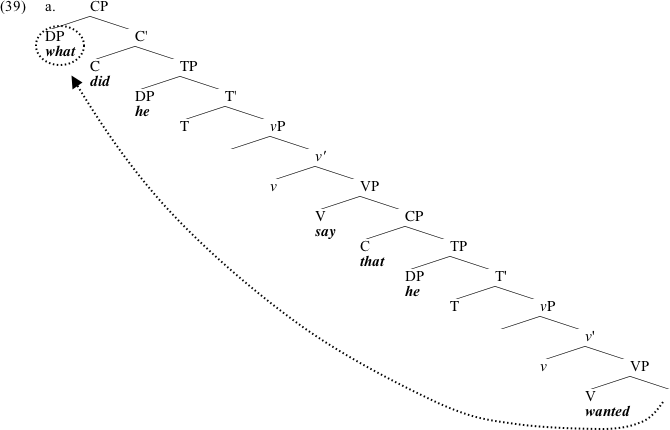
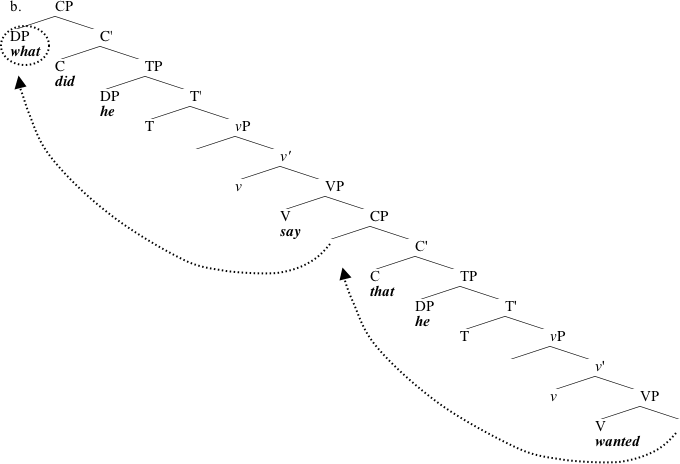
We have several reasons to choose the tree in (39b), in which what stops in the specifier of the lower CP before moving to the higher CP--that is, we have reasons to believe that wh-movement is successive-cyclic. One of these reasons comes from the behavior of West Ulster English discussed above. If we want to add all to the West Ulster English version of (38), we have three options:
(39) What all did he say that he wanted?
(40) What did he say all that he wanted?
(41) What did he say that he wanted all?
We have already seen that West Ulster English allows all to appear in positions previously occupied by the wh-phrase. It comes as no surprise, then, that all can appear in the position where what should first have been Merged, as in (41). The interesting fact is the one in (40); all can appear before the embedded CP. The fact in (40) seems to urge us in the direction of a derivation like the one in (39b); what stops in the specifier of the embedded CP as it moves up the tree.
Another argument for successive-cyclic movement has to do with the interaction of wh-movement with binding theory. Consider an example like (42):
(42) [Which picture of himselfi] did Johni buy?
(42) is well-formed, but the anaphor himself appears not to be bound; it corefers with John, but John does not c-command it. However, we might try to take advantage of the fact that (42) involves wh-movement, and prior to wh-movement, John should c-command himself, since the wh-phrase which picture of himself should begin the derivation as the complement of buy. Apparently binding theory can treat this example as though no movement had happened. This phenomenon, in which binding theory (and certain other aspects of interpretation) seem to treat a sentence as though certain movement operations had not taken place, is known as reconstruction; we'll revisit it later. Now let us consider again a question in which wh-movement crosses a CP boundary:
(43) [Which picture of himselfi] did Johni say that Mary bought?
In (43), the wh-phrase begins as the complement of bought, and ends the derivation as the specifier of the highest CP. In neither of these positions can himself be bound by John; when the wh-phrase is the specifier of the highest CP, John does not c-command himself, and when the wh-phrase is the complement of bought, John is not in the binding domain of himself, as the ill-formedness of (44) confirms:
(44) * Johni said that Mary bought a picture of himselfi.
Binding theory demands, then, that the wh-phrase pass through a position which is closer to John, so that the anaphor inside the wh-phrase can be bound under reconstruction to that position. The binding facts constitute another piece of evidence that wh-movement is successive-cyclic; by landing in the specifier of the embedded CP, the wh-phrase will put himself in a position to be bound by John in a way which satisfies Principle A.